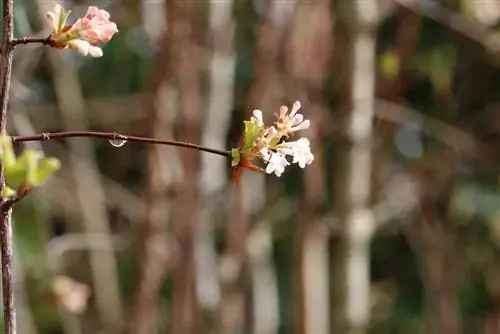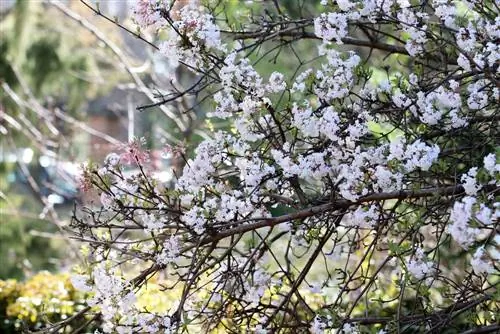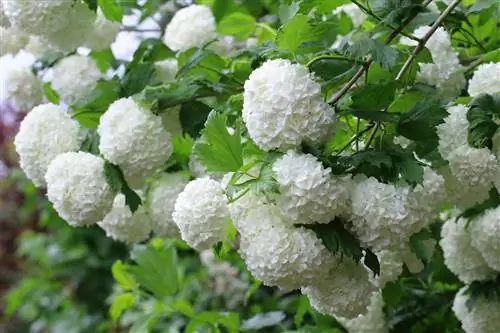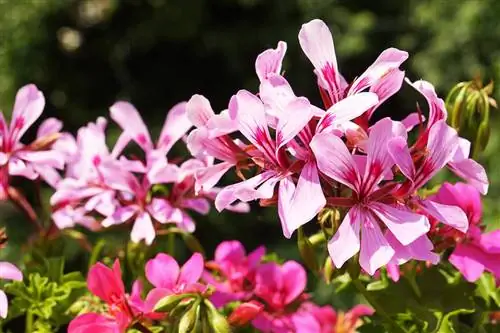- Author admin [email protected].
- Public 2023-12-17 03:39.
- Last modified 2025-01-24 12:45.
The Easter snowball, also known as the evergreen scented snowball, is an early-flowering plant with numerous benefits. Strongly fragrant flower spikes and dense growth characterize the shrub and make it an attractive eye-catcher - even in winter. In addition, the plant is quite undemanding and therefore ideal for beginner hobby gardeners. In order for the Easter snowball to develop its full beauty, the right care measures and, above all, a suitable location are required.
Location
The plant needs plenty of sun for the white flowers of the Easter snowball. If it is too shady, the flowering power will decrease significantly. A location where the evergreen scented snowball does not have to endure the blazing midday sun is therefore ideal. This quickly leads to burns on the leaves, especially in winter. The planting site should therefore face east or west or be slightly shaded. The slow-growing Easter snowball reaches a height of 150 to 200 cm, so it also needs some upward space. This should also be taken into account when selecting the location.
- However, it is important that the soil is particularly nutrient-rich. The soil should be nice and loose. The floor must not allow any water to accumulate.
- If you want to plant the evergreen viburnum in heavy clay soil, you should first mix it with a little sand.
- As an alternative, you can also plant the Easter snowball in a pot. They are ideal as an eye-catcher and as a decorative element on your balcony or terrace. However, make sure that the plant gets enough sun.
- The evergreen snowball can also be used as a grave plant. This means you have evergreen grave planting that rarely needs to be watered.
Substrate
The Easter snowball is quite undemanding when it comes to substrate. Fresh, normal garden soil is sufficient. This should be rich in humus and nutrients, so it is best enriched with compost. A slightly acidic pH value is ideal. Neutral or slightly alkaline soils are also tolerated.
Tip:
If you want to reduce the amount of care required for the evergreen scented snowball and at the same time do something good for the shrub, apply a thick layer of mulch to the substrate.
Pouring
The Easter snowball thrives best when it is always kept slightly moist. However, it quickly reacts sensitively to waterlogging and dryness. Watering is therefore always carried out when the top layer of soil has dried slightly. Sponge watering should only be done when it is very hot and during long dry periods, otherwise watering should be kept small. Tap water, rain water or untreated pond water are suitable. If the soil is already calcareous, it is better to use soft water. Too much lime can put a strain on the evergreen scented snowball. If a layer of mulch has been applied to the substrate, watering is rarely necessary.
Fertilize
Since the Easter snowball has an annual growth of just 15 to 20 cm, i.e. it grows slowly, it only needs a small amount of nutrients. However, it should be lightly fertilized. Organic and natural fertilizers such as plant manure, compost and pond water are suitable for this. These are administered in small quantities approximately every four to eight weeks from spring to late summer. Again, mulch can reduce the effort if it is spread in a thick layer under the evergreen scented viburnum. In this way, it continuously releases nutrients, making additional fertilizing unnecessary.
Cutting
After the flowering period, which usually ends in May, the Easter snowball should be thinned out. The slow growth must be taken into account here, so only a small amount of the shoot length can be removed all around. However, shoots that are too close and grow inwards are removed completely. Stubs should not be left standing.
The clippings are not absolutely necessary for the shrub to thrive, but if they are missing, it quickly becomes noticeable. Young shoots in particular bear the pink buds from which the white flowers develop. The older the branches are, the more the flowering power decreases. Thinning cutting and slight correction of the outer area has a rejuvenating effect and promotes flowering. However, the shrub does not need to be shaped.
Propagate
The easiest way to propagate is to separate the runners that the evergreen scented viburnum forms all by itself. To do this, proceed as follows:
- If runners appear around the Easter snowball, they should be allowed to reach a height of at least 15 to 20 cm. So be careful when mowing the lawn and weeding.
- Once the young shoots have reached the minimum height, they are carefully separated from the mother plant with a spade in late spring or autumn and dug up.
- Freed from the old substrate, they are planted in the desired location and watered well. Applying mulch is recommended as cover and protection against evaporation.
By the way, you shouldn't wait too long before cutting off and moving the Easter snowball tails. The higher the young plant, the deeper its roots reach and the risk of damaging the roots of the adult shrub increases.
In addition to propagation via runners, it is also possible to root cuttings of the evergreen scented viburnum or to form sinkers. Head cuttings about 15 cm long are ideally taken in early autumn and planted in moist soil. For a high chance of success, it is advisable to use planters and keep them cool and bright but frost-free in winter. The substrate is kept slightly moist throughout.

Spring, however, is the best time for rooting the sinkers. To do this, branches that are as long and flexible as possible are pressed onto the ground and weighed down with a stone at a point close to the mother plant. Direct contact with moist soil is important. After about four weeks, the stone can be lifted and the sinker checked for roots. If these are not yet present, the lowering device is weighed down again. If there is a root system, the sinker can be separated from the mother plant with sharp scissors, carefully dug up and moved. Keeping the substrate moist is again important.
Wintering
The evergreen scented viburnum, as the name suggests, has leaves all year round. It is also frost hardy, so it can easily be left in the garden in winter. This also applies if it is cultivated in a bucket. Light protection is still recommended. Mulch and piled-up brushwood are ideal. Garden fleece should also be wrapped around the planter in the bucket after it has been moved to a protected location. The winter sun in particular can cause damage to the leaves, so a place in light shade is recommended. However, the Easter snowball must not be completely darkened. If cuttings were taken in autumn to propagate the shrub and placed in soil, they should be allowed to overwinter frost-free. As already mentioned, this increases the chances of successful rooting. These should also be kept cool, at a maximum of 12 °C and bright. The substrate is also easy to keep moist.
Special features
- Like the other viburnum plants, the Easter viburnum is also a poisonous plant.
- Depending on care and location, the Easter snowball can reach a height of around two meters to two meters sixty.
- Thanks to its densely growing branches, the plant is also ideal as a privacy screen, for example for a hedge.
- The only disadvantage is that it takes a very long time before the Easter snowball reaches the desired height.
Care
- As a rule, it is enough to water the evergreen viburnum every two weeks. So only water when the soil around the plant is very dry.
- You can also avoid fertilizing the plant - at least if it is in the ground.
- If you have the plant in a pot, you can give it some fertilizer every now and then.
- Pruning the Easter snowball is not absolutely necessary. If so, you should do this after flowering.
Tip:
However, keep in mind that the evergreen viburnum can bloom again in autumn. If you cut too much, the second flower will usually not appear. The plants also form many runners so that they multiply in no time.
When caring for them, make sure that the plants are not attacked by pests. The main concern here is the snowball beetle. If it is not recognized and combated in time, it can eat away all of the plant's leaves. If there is an infestation, you have to act quickly and fight the beetle with chemical agents.
Conclusion
The Easter snowball is a decorative plant that requires little care in the right location. The already low effort can be further reduced if mulch is applied regularly. If you also trim the bush every year, you can enjoy the lush and incomparably fragrant flowers for a long time.






